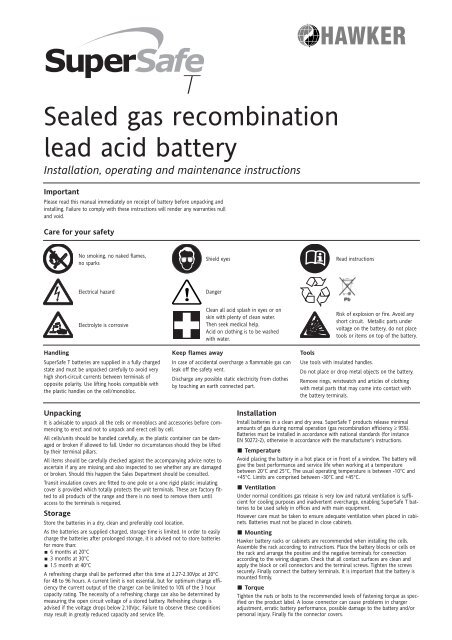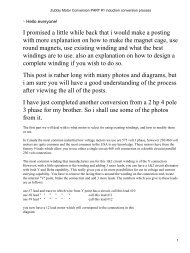Sealed gas recombination lead acid battery - Otherpower
Sealed gas recombination lead acid battery - Otherpower
Sealed gas recombination lead acid battery - Otherpower
Create successful ePaper yourself
Turn your PDF publications into a flip-book with our unique Google optimized e-Paper software.
<strong>Sealed</strong> <strong>gas</strong> <strong>recombination</strong><br />
<strong>lead</strong> <strong>acid</strong> <strong>battery</strong><br />
Installation, operating and maintenance instructions<br />
Important<br />
Please read this manual immediately on receipt of <strong>battery</strong> before unpacking and<br />
installing. Failure to comply with these instructions will render any warranties null<br />
and void.<br />
Care for your safety<br />
No smoking, no naked flames,<br />
no sparks<br />
Shield eyes<br />
Read instructions<br />
Electrical hazard<br />
Danger<br />
Electrolyte is corrosive<br />
Handling<br />
SuperSafe T batteries are supplied in a fully charged<br />
state and must be unpacked carefully to avoid very<br />
high short-circuit currents between terminals of<br />
opposite polarity. Use lifting hooks compatible with<br />
the plastic handles on the cell/monobloc.<br />
Clean all <strong>acid</strong> splash in eyes or on<br />
skin with plenty of clean water.<br />
Then seek medical help.<br />
Acid on clothing is to be washed<br />
with water.<br />
Keep flames away<br />
In case of accidental overcharge a flammable <strong>gas</strong> can<br />
leak off the safety vent.<br />
Discharge any possible static electricity from clothes<br />
by touching an earth connected part.<br />
Risk of explosion or fire. Avoid any<br />
short circuit. Metallic parts under<br />
voltage on the <strong>battery</strong>, do not place<br />
tools or items on top of the <strong>battery</strong>.<br />
Tools<br />
Use tools with insulated handles.<br />
Do not place or drop metal objects on the <strong>battery</strong>.<br />
Remove rings, wristwatch and articles of clothing<br />
with metal parts that may come into contact with<br />
the <strong>battery</strong> terminals.<br />
Unpacking<br />
It is advisable to unpack all the cells or monoblocs and accessories before commencing<br />
to erect and not to unpack and erect cell by cell.<br />
All cells/units should be handled carefully, as the plastic container can be damaged<br />
or broken if allowed to fall. Under no circumstances should they be lifted<br />
by their terminal pillars.<br />
All items should be carefully checked against the accompanying advice notes to<br />
ascertain if any are missing and also inspected to see whether any are damaged<br />
or broken. Should this happen the Sales Department should be consulted.<br />
Transit insulation covers are fitted to one pole or a one rigid plastic insulating<br />
cover is provided which totally protects the unit terminals. These are factory fitted<br />
to all products of the range and there is no need to remove them until<br />
access to the terminals is required.<br />
Storage<br />
Store the batteries in a dry, clean and preferably cool location.<br />
As the batteries are supplied charged, storage time is limited. In order to easily<br />
charge the batteries after prolonged storage, it is advised not to store batteries<br />
for more than:<br />
6 months at 20°C<br />
3 months at 30°C<br />
1.5 month at 40°C<br />
A refreshing charge shall be performed after this time at 2.27-2.30Vpc at 20°C<br />
for 48 to 96 hours. A current limit is not essential, but for optimum charge efficiency<br />
the current output of the charger can be limited to 10% of the 3 hour<br />
capacity rating. The necessity of a refreshing charge can also be determined by<br />
measuring the open circuit voltage of a stored <strong>battery</strong>. Refreshing charge is<br />
advised if the voltage drops below 2.10Vpc. Failure to observe these conditions<br />
may result in greatly reduced capacity and service life.<br />
Installation<br />
Install batteries in a clean and dry area. SuperSafe T products release minimal<br />
amounts of <strong>gas</strong> during normal operation (<strong>gas</strong> <strong>recombination</strong> efficiency ≥ 95%).<br />
Batteries must be installed in accordance with national standards (for instance<br />
EN 50272-2), otherwise in accordance with the manufacturer’s instructions.<br />
Temperature<br />
Avoid placing the <strong>battery</strong> in a hot place or in front of a window. The <strong>battery</strong> will<br />
give the best performance and service life when working at a temperature<br />
between 20°C and 25°C. The usual operating temperature is between -10°C and<br />
+45°C. Limits are comprised between -30°C and +45°C.<br />
Ventilation<br />
Under normal conditions <strong>gas</strong> release is very low and natural ventilation is sufficient<br />
for cooling purposes and inadvertent overcharge, enabling SuperSafe T batteries<br />
to be used safely in offices and with main equipment.<br />
However care must be taken to ensure adequate ventilation when placed in cabinets.<br />
Batteries must not be placed in close cabinets.<br />
Mounting<br />
Hawker <strong>battery</strong> racks or cabinets are recommended when installing the cells.<br />
Assemble the rack according to instructions. Place the <strong>battery</strong> blocks or cells on<br />
the rack and arrange the positive and the negative terminals for connection<br />
according to the wiring diagram. Check that all contact surfaces are clean and<br />
apply the block or cell connectors and the terminal screws. Tighten the screws<br />
securely. Finally connect the <strong>battery</strong> terminals. It is important that the <strong>battery</strong> is<br />
mounted firmly.<br />
Torque<br />
Tighten the nuts or bolts to the recommended levels of fastening torque as specified<br />
on the product label. A loose connector can cause problems in charger<br />
adjustment, erratic <strong>battery</strong> performance, possible damage to the <strong>battery</strong> and/or<br />
personal injury. Finally fix the connector covers.
Cell strings connected in parallel<br />
Using constant voltage chargers and ensuring that the connections made between<br />
the charger and the batteries have the same electrical resistance, no special<br />
arrangements have to be made for batteries in parallel.<br />
Although no special circuit arrangements are required, where the parallel connection<br />
is made at the charger or distribution board, to avoid out of step conditions,<br />
the bus bar run length and the area of cross section should be designed so that<br />
the circuit resistance value for each of the strings is equal within limits ± 5%.<br />
Charging<br />
Float voltage<br />
The float/charge voltage is 2.28Vpc at 20°C.<br />
When the average ambient temperature deviates more than ±5°C from the reference,<br />
it is necessary to adjust the float voltage as follows:<br />
Discharging<br />
SuperSafe T batteries must not be left in a discharged condition after supplying<br />
the load, but must immediately return to float recharge mode.<br />
Failure to observe these conditions may result in greatly reduced service life.<br />
Accidental deep discharging<br />
For optimum operation the minimum voltage of the system should be related to<br />
the duty as follows:<br />
Duty<br />
Minimum end voltage<br />
5 min ≤ t ≤ 1h 1.65V<br />
1h ≤ t ≤ 5h 1.70V<br />
5h ≤ t ≤ 8h 1.75V<br />
8h ≤ t ≤ 20h 1.80V<br />
Temperature<br />
Float voltage range per cell<br />
0°C 2.33-2.36V<br />
10°C 2.30-2.33V<br />
20°C 2.27-2.30V<br />
25°C 2.25-2.28V<br />
30°C 2.24-2.27V<br />
35°C 2.22-2.25V<br />
40°C 2.21-2.24V<br />
Due to the phenomena of <strong>gas</strong> <strong>recombination</strong> a difference of ±2% (earlier in float<br />
life ±5% is common) for an individual cell voltage can be observed. However the<br />
total voltage shall be within the limits stated above.<br />
If the charger does not permit an adjustment of float voltage in relation with the<br />
temperature, it is possible to set a float voltage value according to the temperature<br />
ranges as indicated in the last table of this publication.<br />
Charging current<br />
A discharged VRLA <strong>battery</strong> will accept a high recharge current, but for those<br />
seeking a more economical charging system a current limit of 0.08 C10 : 0.1 C3 (A)<br />
is adequate.<br />
Fast recharge<br />
Increasing the charge voltage to 2.40Vpc with a current limited to 0.1 C10 : 0.125<br />
C3 (A) can reduce recharge times. Fast charge should be stopped after approximately<br />
10 to 15 hours. This charge regime, in order to achieve a normal service<br />
life, must not be used more than once per month.<br />
Float charge ripple<br />
Excessive ripple on the D.C. supply across a <strong>battery</strong> has the effect of reducing life<br />
and performance.<br />
It is therefore recommended that voltage regulation across the system, including<br />
the load but without the <strong>battery</strong> connected, under steady state conditions, shall<br />
be better than ±1% through 5% to 100% load.<br />
State of charge<br />
The <strong>battery</strong> state of charge can be determined approximately by measuring the<br />
open circuit voltage after the <strong>battery</strong> has been at rest for a minimum of 24 hours<br />
at 20°C.<br />
Voltage<br />
State of charge<br />
2.14Vpc 100%<br />
2.10Vpc 80%<br />
2.07Vpc 60%<br />
2.04Vpc 40%<br />
2.00Vpc 20%<br />
Open circuit voltage variation with temperature is 2.5mV per 10°C.<br />
Hawker S.A.<br />
Rue Alexander Fleming ZI EST BP 962<br />
62033 Arras Cedex France<br />
Tel: + 33 3 21 60 25 25 Fax: + 33 3 21 73 16 51<br />
www.hawker.invensys.com<br />
E-mail : hawker.france@hawker.invensys.com<br />
In order to protect the <strong>battery</strong> it is advisable to have system monitoring and low<br />
voltage cut-out.<br />
Deep discharge will produce a premature deteriation of the <strong>battery</strong> and a noticeable<br />
reduction in the life expectancy of the <strong>battery</strong>.<br />
The effect of temperature<br />
- on capacity<br />
Correction factors of the capacity, according to the temperature, are as follows:<br />
Discharge 0°C 5°C 10°C 15°C 20°C 25°C 30°C 35°C 40°C<br />
Time<br />
5 mins to 0.80 0.86 0.91 0.96 1 1.04 1.06 1.09 1.1<br />
59 mins<br />
1h to 24h 0.86 0.90 0.94 0.97 1 1.03 1.05 1.06 1.07<br />
- on life<br />
Operation of valve regulated batteries at temperatures higher than 20°C will<br />
reduce life expectancy. Life is reduced by 50% for every 10°C rise in temperature.<br />
Maintenance/Checks<br />
SuperSafe T are maintenance free, sealed, <strong>lead</strong> <strong>acid</strong> batteries and need no water<br />
addition.<br />
The containers and lids shall be kept dry and free from dust. Cleaning must be<br />
done only with a damp cotton cloth. Check monthly that total voltage at <strong>battery</strong><br />
terminals is (N x 2.28 V) for a temperature at 20°C. (N being the number of cells<br />
in the <strong>battery</strong>). Make annual readings of the voltages of cells making up the <strong>battery</strong>.<br />
Keep a logbook to record values, power outages, discharge tests, etc.<br />
An autonomy control can be done once a year.<br />
Technical data when charging with a constant<br />
voltage<br />
If the charger does not permit an adjustment of the float voltage in relation with<br />
the temperature, it is possible to set a float voltage value and a recharging voltage<br />
value according to the temperature ranges as indicated in the table below:<br />
Temperature Float Voltage Recharging Voltage<br />
0°C to 10°C 2.34Vpc 2.45Vpc<br />
10°C to 20°C 2.31Vpc 2.40Vpc<br />
20°C to 30°C 2.28Vpc 2.35Vpc<br />
30°C to 40°C 2.25Vpc 2.30Vpc<br />
Hawker Worldwide Marketing<br />
Rake Lane Clifton Junction Swinton<br />
Manchester M27 8LR, UK<br />
Tel: +44 (0)161 794 4611 Fax: +44 (0)161 793 6606<br />
www.hawker.invensys.com<br />
DCE 1009G/04-01 - Subject to revisions without prior notice.<br />
Please refer to the website address for details of your nearest Hawker office





